Neuroendocrine Cancer of the Stomach
Here, you’ll find resources tailored to those affected by stomach neuroendocrine cancer. We offer comprehensive information on causes, symptoms, diagnosis, and treatment options. Dive into inspiring patient stories, stay updated on research developments, and access expert insights. Our community is here to support you, providing both emotional guidance and practical advice.
Explore treatment approaches, connect with others who understand your journey, and discover ways to lead a fulfilling life during and after treatment. You’re not alone in this – together, we’re here to educate and support.
Click to skip to:
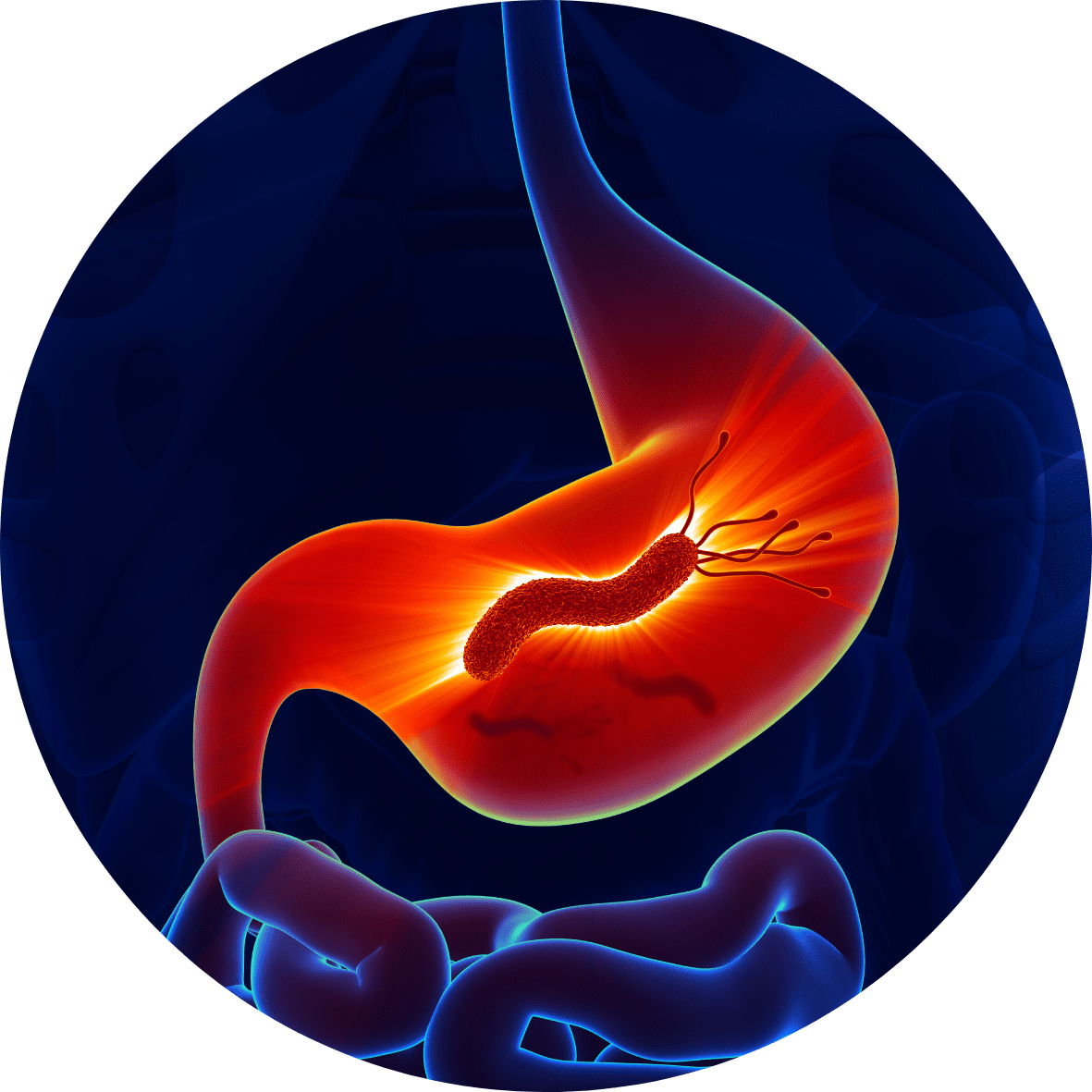
The Facts
Neuroendocrine Neoplasm (NENs) serves as an umbrella term encompassing a cluster of cancers originating in neuroendocrine cells. These cancers might also be denoted as NETs, NECs, or Carcinoids. NENs manifest when neuroendocrine cells deviate from their normal function, undergoing abnormal growth or behaviour.
Two principal types of NEN exist:
1. NETs (neuroendocrine tumours): Characterised as ‘well-differentiated‘, these tumours usually exhibit a gradual to moderate growth pattern.
2. NECs (neuroendocrine carcinomas): Identified as ‘poorly differentiated‘, these tumours tend to grow rapidly.
To simplify matters, we employ the term NENs throughout this page.
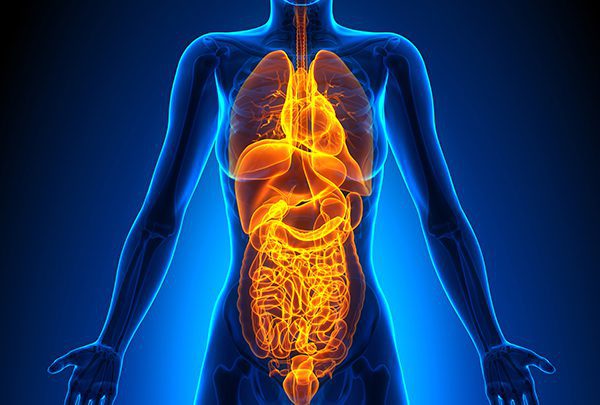
Stomach NENs
Stomach NENs are rare, comprising less than 2% of all stomach cancers. Among these cases, there are three primary types, with the possibility of a fourth:
1. Type 1: This is the most common type (70-80%), typically presenting as small lesions, often less than 10mm in size and may occur in multiples. They tend to be non-aggressive, well-differentiated, and rarely metastasise. Type 1 NENs may be associated with Atrophic and/or Auto-immune Gastritis and/or H.Pylori infection.
2. Type II: Accounting for approximately 7-10% of cases, Type II NENs share similarities with Type I, including their small size and potential multiplicity. They are usually slow-growing, well-differentiated, but have a slightly higher likelihood of metastasis. Type II NENs may be associated with Zollinger-Ellison Syndrome (ZES) and/or MEN1.
3. Type III: Representing roughly 20% of cases, Type III NENs typically manifest as solitary, larger lesions (often 2 or more centimetres in size). They can exhibit well- or poorly differentiated cells and tend to grow more rapidly than Type I or II, making them more likely to metastasise.
Note: Some experts suggest formally subdividing Type III based on cancer cell differentiation, distinguishing between well and poorly differentiated forms.
Stomach Neuroendocrine Cancer
Click “Play” to view Prof. Martyn Caplin, Consultant in gastroenterology and hepatobiliary medicine at the Royal Free Hospital in London provides information on Stomach Neuroendocrine Cancer.
Symptoms
Symptoms can vary, depending on the grade, stage, and underlying causes:
Common Symptoms:
- Stomach discomfort/pain
- Reflux: regurgitation, heartburn, dyspepsia
- The feeling of fullness in the upper abdomen after eating (early satiety)
- Reduced appetite
- Unintentional weight loss
- Anaemia (low iron and/or B12)
- Stomach and/or duodenal irritation leading to nausea and/or vomiting (vomit may or may not contain blood)
- Darkening of faeces (black or very dark stools).
Type I Stomach NETs: Typically not associated with neuroendocrine cancer-associated syndromes.
Type II Stomach NETs: May be associated with Zollinger-Ellison syndrome (ZES) and/or MEN1 symptoms.
Type III Stomach NETs: Carcinoid Syndrome may develop if the disease spreads to the liver (metastasises), although this occurrence is rare.
Other Symptoms: Rare symptoms, including Paraneoplastic syndrome and oncological emergencies, such as raised calcium levels (Hypercalcaemia), may occur.
For further details about MEN1, you can find valuable information at www.amend.org.uk
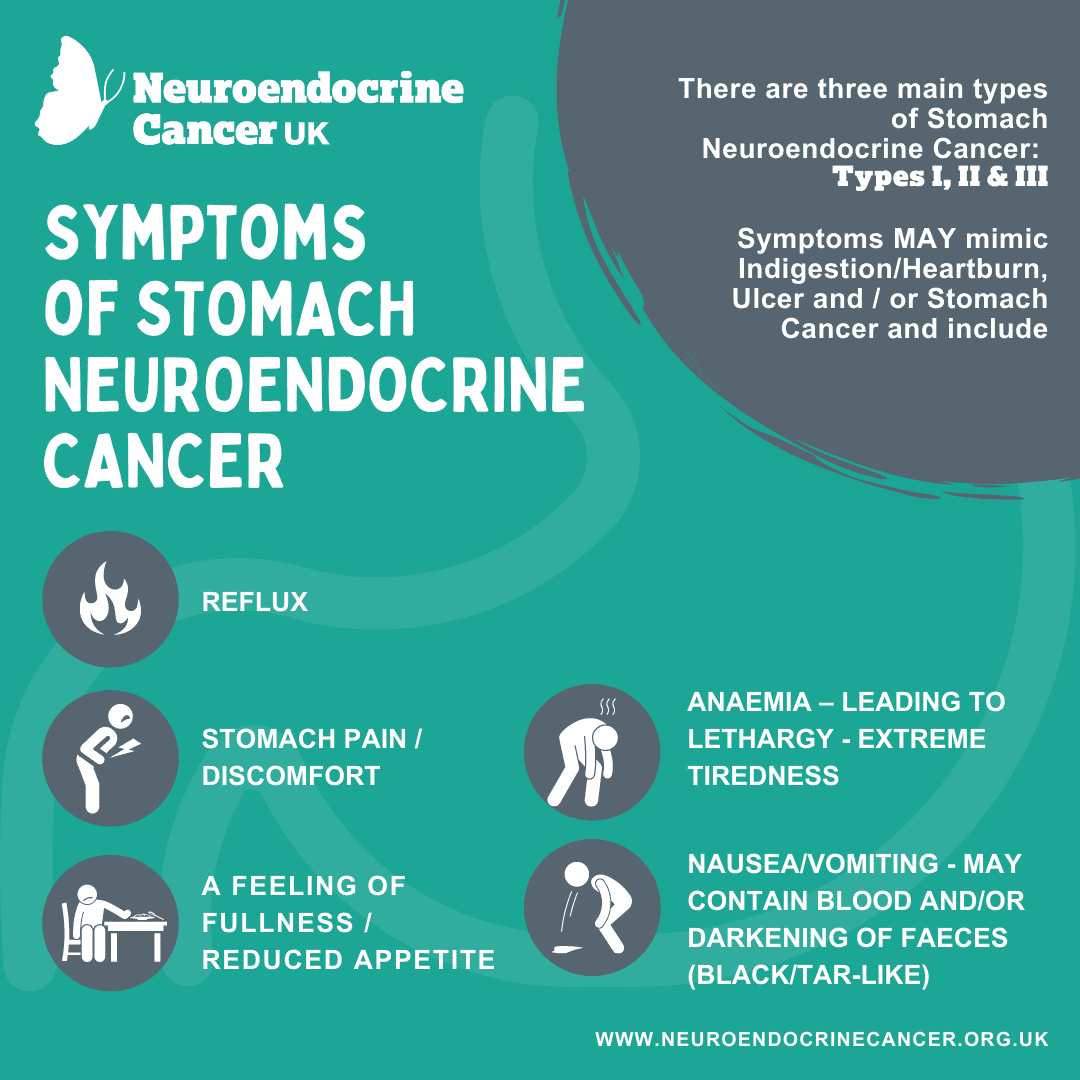
Types of Tests
Tests that may be used to diagnose and monitor Neuroendocrine Cancer of the Stomach
Type I: This type is often associated with low vitamin B12 levels, the presence of anti-parietal cell antibodies, and anti-intrinsic factor antibodies. Gastric pH may be high (>4).
Type II: This type is linked to Zollinger-Ellison syndrome and Gastrinomas, often occurring as part of MEN1. While vitamin B12 levels may be normal, iron deficiency is common. Anti-parietal cell antibodies may test negative, but gastrin levels (when off PPIs) are typically high, although gastric pH may be low (<2).
Type III: This type is not typically associated with elevated gastrin levels, despite the presence of ulceration.
Bloods and/or urine:
- Full blood count
- B12 (+ serum Iron)
- Parietal cell and intrinsic factor antibodies
- Liver and kidney function
Biochemical:
- Chromogranin A (and B)
- Urinary 5-HIAA
- Gastric pH
- Genetic analysis is recommended in case of suspected MEN-1
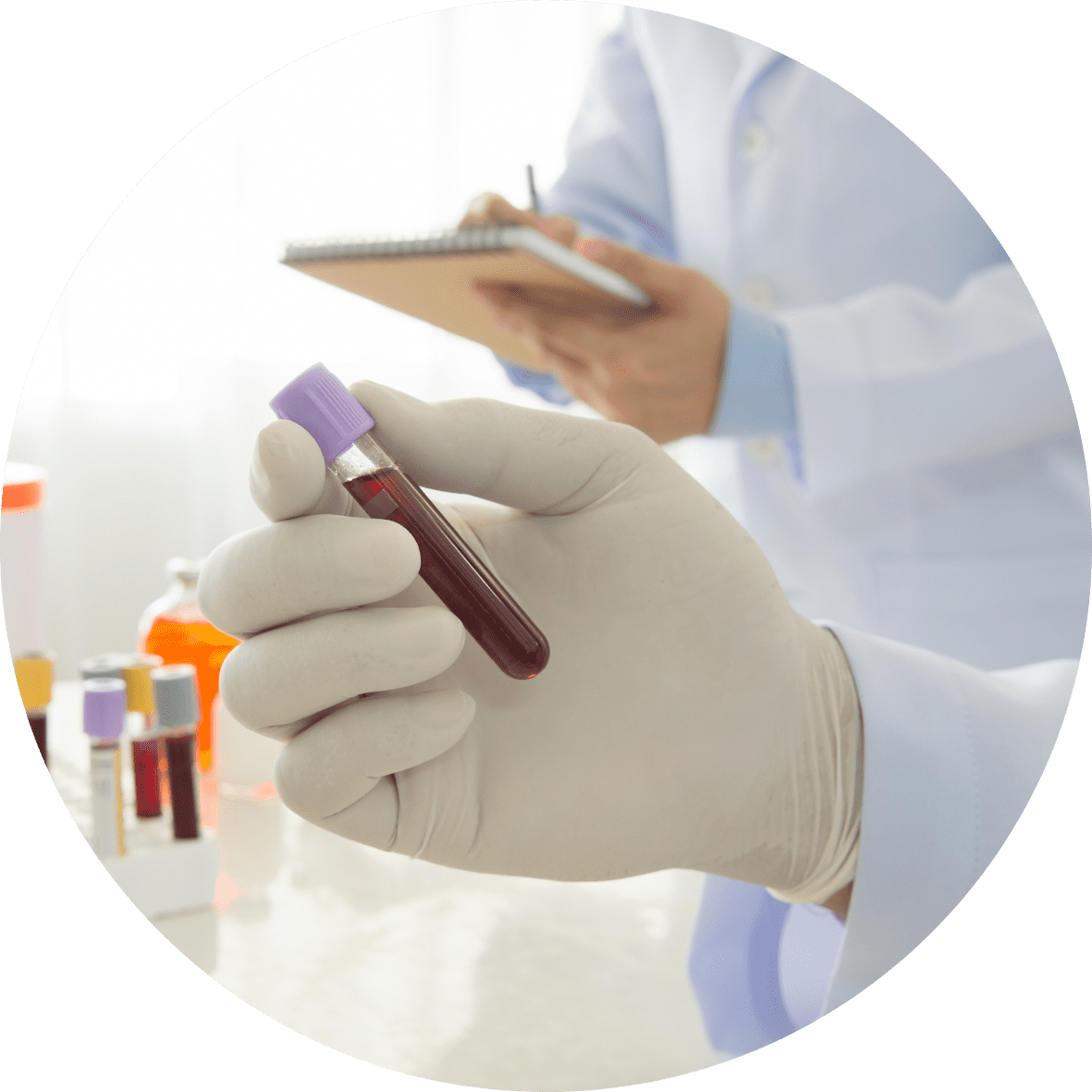
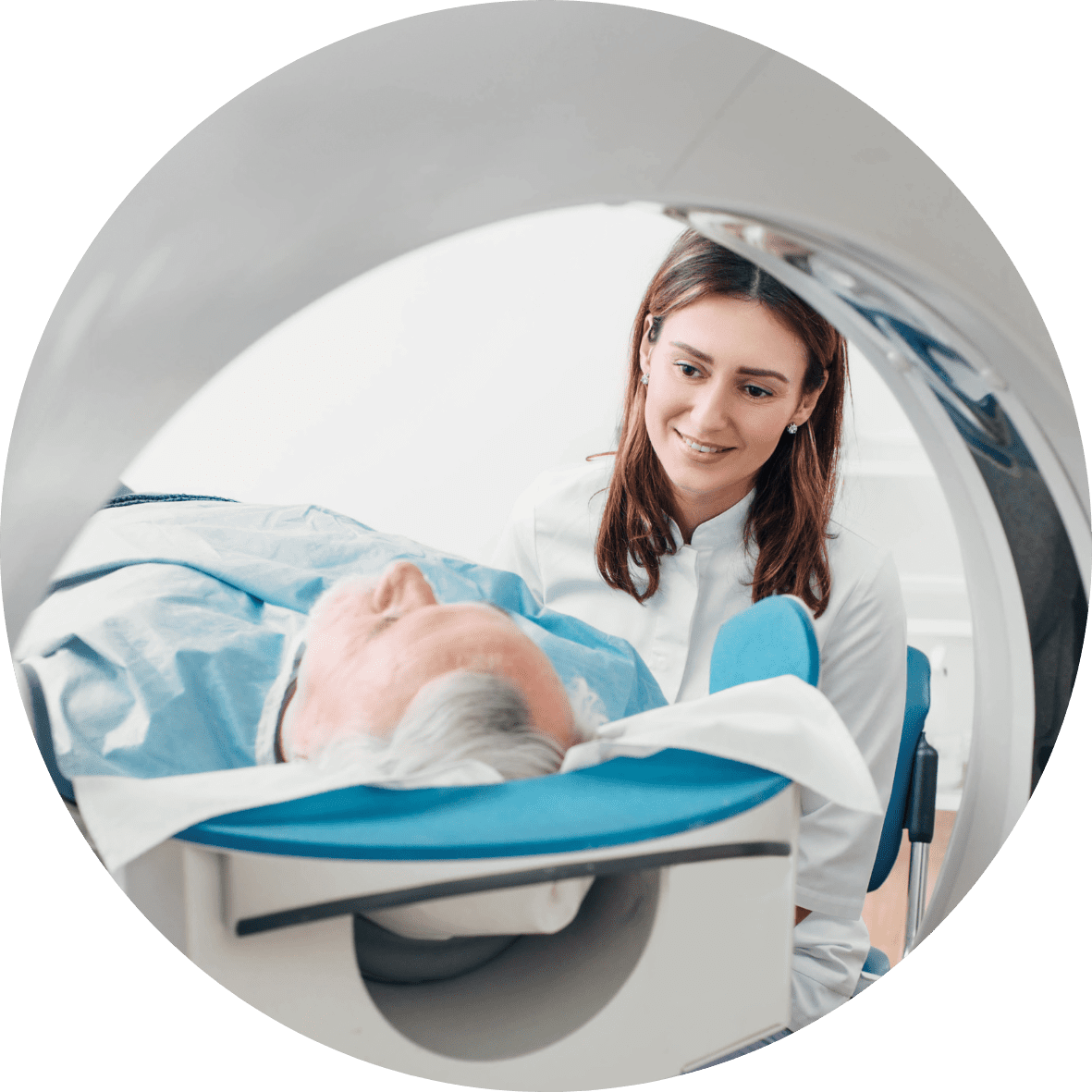
Scans and other tests:
- Upper endoscopy – OGD +/- biopsy
- Endoscopic Ultrasound (EUS) +/- biopsy
- CT or MRI – for type III
- Octreotide (SPECT) scan or Gallium-Dotatate PET/CT: type II and III
- FDG-PET – if High Grade / rapidly progressing disease
Pathology (what can be seen through special tests under a microscope):
- Differentiation and cellular morphology
- Haematoxylin and eosin
- Synaptophysin
- Chromogranin
Expert recommendation for Type 1 disease includes biopsying the background mucosa to check for evidence of dysplasia.

Diagnosis and Grading
Receiving a diagnosis of lung neuroendocrine cancer can be an unexpected and challenging moment in your life. We understand the range of emotions and questions that may arise during this time, and we’re here to provide you with the support and information you need.
Stomach neuroendocrine cancer is a complex condition with various subtypes and behaviours. Each diagnosis is unique, and understanding your situation is essential for making informed decisions about your care. It’s important to remember that not all cancers are the same – some may grow slowly, while others are more aggressive. This diversity underscores the significance of understanding your diagnosis and its implications.
Our ‘Just Diagnosed’ page is designed to be your go-to resource during this pivotal phase. We offer valuable information on what to expect, access to specialist care, and emotional support.
More than just information, our website also connects you with a supportive community. Sharing experiences with others who have faced similar challenges can be profoundly comforting and enlightening. We encourage you to explore our online community groups and support groups, where you can find understanding, advice, and a network of individuals ready to uplift you.
Remember, you’re not alone on this pathway. Together, we can navigate the intricacies of lung neuroendocrine cancer and work towards the best possible outcomes. Visit our ‘Just Diagnosed’ page to access resources and connect with a community that cares. Your well-being is our priority, and we’re here to stand by your side every step of the way.
Understanding Grading
Cancers vary significantly in their characteristics and behaviour. Differences in growth speed, invasiveness into nearby tissues, and the potential for spreading to other parts of the body exist among different cancer types. While some cancers progress slowly and may not have invaded nearby structures or metastasised, they still harbour the potential to do so. Conversely, certain cancers may have already spread by the time of diagnosis.
Cancer grading indicates the rate of its growth. You might come across terms like ‘Ki67’ or ‘Mitotic Index’ in your clinic letters or medical reports, which are indicators of the cancer’s grade. This classification spans from Grade 1, indicating slow growth, to Grade 3, signifying a more aggressive and rapidly progressing disease. Understanding the grade offers valuable insights into the behaviour and potential course of the NEN.
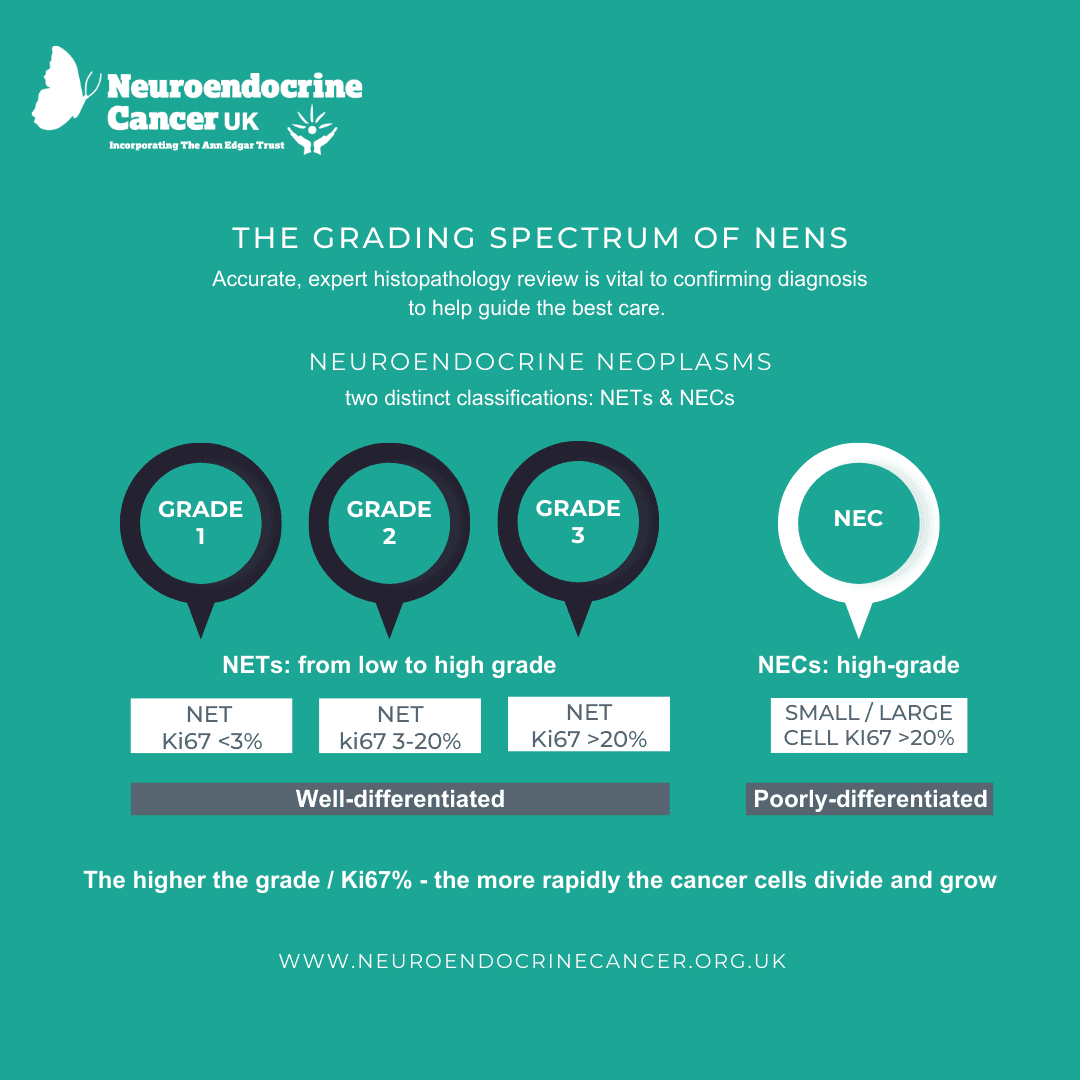
How is Stomach Neuroendocrine Cancer Treated?
When it comes to planning treatments for all patients, several factors come into play. Your treatment plan will be tailored specifically to you, considering the type of NEN you have. Even if your diagnosis seems similar to another patient’s, your treatment and follow-up plan may differ.
Your healthcare team will engage in thorough discussions about your treatment options, providing you with both written and verbal information to ensure you can make an informed decision. Together, you and your medical team can determine the most suitable treatment for your unique circumstances. It’s widely agreed that all NEN patients should undergo review by a specialist Multidisciplinary Team (MDT).
The choice of treatment options depends on various factors, including the type, location, and size of your NEN, as well as whether it has spread and to what extent. Additionally, your overall health, any other medical conditions, and your general fitness will be considered. When meeting with your doctors or specialist nurse/team, the primary goal is to provide you with the information necessary to understand your condition fully.
The primary goal of treatment is to provide you with the best possible care and quality of life. This involves access to appropriate treatments, symptom management, and addressing your unique priorities.
The choice of treatment options depends on several factors, including the type, location, and size of your cancer, as well as whether it has metastasised. Additionally, your overall health and any other medical conditions will be considered.
Your treatment plan may include one or more of the following approaches:
- Surgery
- Disease control to slow or halt further growth and spread
- Palliative care to alleviate any symptoms you may be experiencing.
Monitoring through regular clinic reviews, blood tests, and scans serves as a valuable means to assess the effectiveness of your treatment or during intervals between treatments, which may extend for months or even years. Since not everyone requires ongoing treatment, surveillance plays a crucial role in periodically evaluating your cancer and overall health for any signs of change that might warrant consideration of treatment.
It’s worth noting that all treatments carry potential side effects. Therefore, it’s essential to determine when treatment would be beneficial for you and when it might not be necessary.
The approach to treating your neuroendocrine cancer depends on factors such as its location, size, position, and extent of spread. Stomach cancers can manifest in different ways—some develop within polyps, while others form solid tumors.
Polyps, which are small cell clumps, can take two forms:
- Pedunculated Polyps: These polyps hang from a short stalk.
- Sessile Polyps: These are flat and grow directly from the surrounding tissue.
If your neuroendocrine cancer is within a polyp, it may be possible to remove it through:
- Polypectomy: This involves the removal of polyps during endoscopy using hot or cold forceps or a snare.
- EndoMucosal Resection (EMR): During EMR, an endoscope is inserted at the site of the polyp. A small needle is used to inject fluid beneath the polyp, creating a safe area for its removal using a snare. The site is then cauterised to prevent bleeding.
The procedure is similar to EMR but employs a small knife instead of a snare to remove the polyp, simultaneously cauterising blood vessels to prevent bleeding.
If endoscopic removal is not possible for your neuroendocrine cancer, open surgery may be necessary, which may involve:
- Sub-Total Gastrectomy: This procedure removes a portion of the stomach through an abdominal incision.
- Total Gastrectomy: In this case, the entire stomach is removed through a similar abdominal incision.
Non-surgical treatments:
- Somatostatin Analogues (SSAs)
- Chemotherapy
- Targeted Molecular Therapies
- Peptide Receptor Radionuclide Therapy (PRRT)
- Endoscopic Procedure
- Interventional Radiology
- Clinical Trials
- Symptom Control
Somatostatin analogs (SSAs) can play a crucial role in regulating hormone secretion when abnormal levels are being produced. Additionally, SSAs may be employed to decelerate the growth rate in cases of low to moderate-grade ‘well-differentiated’ neuroendocrine cancer (NET).
Chemotherapy can be administered either orally (in tablet form) or intravenously (through a vein) with the aim of slowing tumour growth or reducing tumour size. In high-grade disease, particularly in ‘poorly differentiated’ NEC, it may be the first-line therapy or used in combination with other treatments. Additionally, chemotherapy may be employed to increase tumor cell sensitivity to radiation therapies.
Chemotherapy can be administered orally (in tablet form) or intravenously (through a vein) to slow tumour growth or attempt to reduce tumor size.
Radioligand Therapy, sometimes referred to as Targeted Radiation Therapy, utilises focused radiation to target and treat neuroendocrine cancer cells. It is often considered for patients who have received a ‘positive’ Octreotide or Gallium scan, indicating ‘receptor-positive’ disease.
Endoscopic treatment, such as the removal of a stomach or rectal polyp, can be performed via endoscopy.
Techniques like emboliSation or ablation can be employed to treat Neuroendocrine Cancer that may develop in the liver and/or lungs.
Clinical research and the development of safe, new treatments are essential to provide the best care for those with neuroendocrine cancer. It’s crucial to ensure that treatments not only work but are also safe.
Clinical trials involve several phases, and you can find more information here. Each trial has specific criteria for patient suitability, which you can discuss with your clinical team.
Participation in a trial is entirely voluntary, and you are not obligated to take part.
Managing symptoms, including pain and underlying conditions, is an integral component of comprehensive care. This approach is applied throughout the entire care pathway, not just during ‘end-of-life’ stages.
Symptom control, often referred to as ‘palliation,’ aims to alleviate or reduce the impact of your cancer, other health concerns, and treatments on your physical and mental well-being. Palliation encompasses a range of options, from simple medications to a combination of the treatments mentioned above, as well as counseling and practical support.
Follow-up and Management of Stomach NENs
While there are expert-agreed guidelines regarding how and when follow-up should occur, it’s important to note that practical approaches can vary, often with good reason.
Follow-up care should be expert-informed, evidence/research-based, and tailored to your unique needs for the best possible care.
For patients with neuroendocrine cancer of the stomach, especially following excision:
Type I: Conservative management typically involves lab and clinical control every 6–12 months, as clinically indicated. Additionally, it may include esophagogastroduodenoscopy (OGD) with biopsies and/or polyp resection every 12–24 months.
Type II: For Type II tumours, endoscopy should be repeated yearly along with lab monitoring. Polyps less than 1cm can be managed similarly to Type I.
Type III and IV: Patients who have undergone sub-total or total gastrectomy should follow the programmes indicated for gastric adenocarcinomas.
Type III and IV (Inoperable or Metastatic): Patients in this category should follow the adenocarcinoma protocol, taking into account general health, symptoms, treatment options, and individual preferences.
In cases of advanced disease, follow-up should align with guidelines, but it should also be guided by prognosis, expected treatment efficacy, and treatment-related considerations.
Your overall health, well-being, physical activity, informed choices, and preferences for ongoing care should be reviewed and discussed to plan your care optimally.
Causes / Risk Factors
While the exact causes of NENs remain unknown, ongoing research aims to gain a comprehensive understanding of both the pathology and biology, offering hope for improved insights into their origins.
Although the majority of NENs are not hereditary, certain rare conditions can elevate your risk. If other family members have been diagnosed with a specific cancer, particularly at a young age (50 years or younger), or if there is a history of cancer-associated genetic conditions in your family, it’s essential to inform your specialist team. This ensures that they have a complete picture of your medical history, including any family medical illnesses or conditions.
Expert Insights
Dive into a wealth of knowledge with our video collection from leading Lung Neuroendocrine Cancer care experts.
Prof. Mark Pritchard shines a spotlight on Gastric Neuroendocrine Tumours (NETs). In this informative video, Prof. Pritchard delves into the intricacies of these tumours, offering valuable insights into their diagnosis, treatment, and impact on patients.
Stories and Experiences
Further Support
For those seeking support, we offer resources such as support groups and online groups that provide a platform for patients and their families to connect, share experiences, and find comfort in a strong network.
Additionally, we encourage individuals to consider participating in clinical trials or research studies, as this contributes to the advancement of NEN understanding and treatment and empowers patients to engage in their healthcare journey actively.
Thank you for choosing us as your resource for Lung Neuroendocrine Cancer information. We are dedicated to providing accurate, insightful, and supportive content as you navigate this pathway. If you have any further questions or concerns, please don’t hesitate to reach out.
